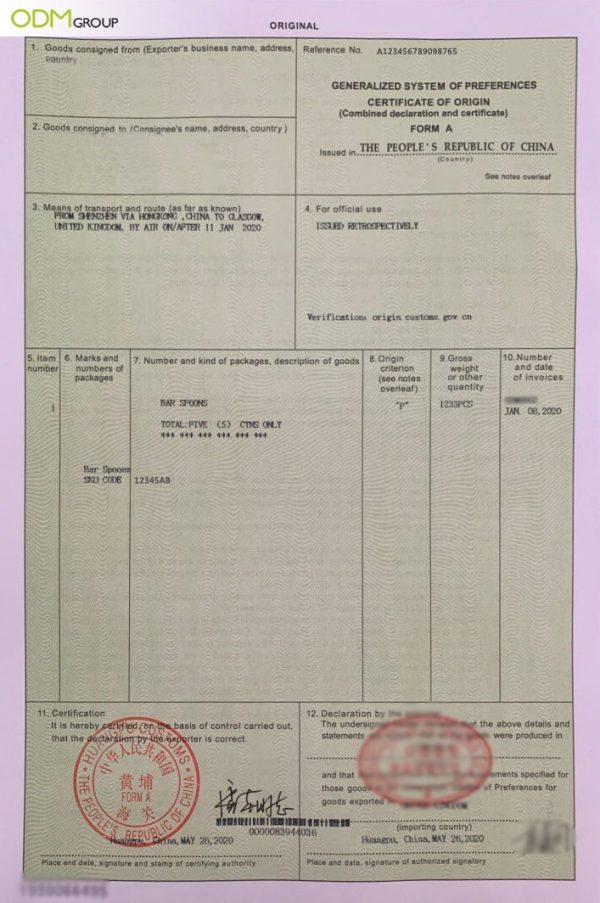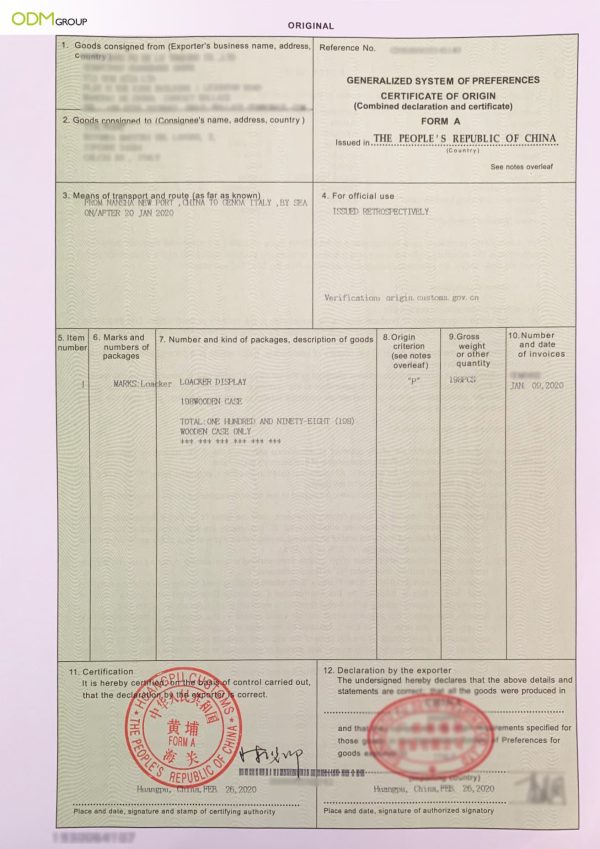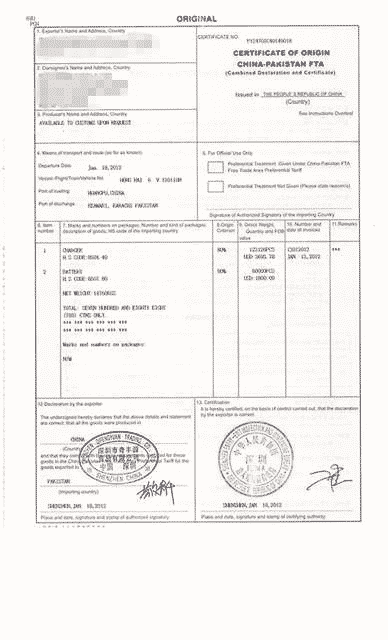What is a certificate of origin? If you are shipping merchandise goods overseas, it is imperative to understand why this is an integral part of shipping promotional products from China. In this blog, we will explain what it is, who provides this document and why you should request a C/O (Certificate of Origin).
Below is an example of a Certificate of Origin that we have provided for a client (some information is altered).

Certificate of Origin
Certificate of Origin Defined
In a nutshell, a C/O is a document showing that a particular imported product is manufactured and obtained from a particular country. In addition to the origin, it also details the number and kind of packages as well as a brief product description and country of export.

Certificate of Origin
Who Issues the Certificate of Origin?
The C/O is issued by the International Chamber of Commerce and can typically be completed within 2-3 working days, sans public holidays. As such, it is incredibly important for importers to request a C/O in the early stages of production. Doing so prevents delays in shipping and allows business owners to plan ahead of time.
The C/O can also be applied for after the shipment has departed, such as when shipping info like the vessel name and number is made available, as long as it is completed before the shipment enters the destination country.
Businesses that are lawfully established in China and those that enjoy the right to engage in foreign trade can apply for a C/O from the General Administration of Quality Supervision, Inspection, and Quarantine of the People’s Republic of China (AQSIQ).
Generally, importers should check with their local brokers if a C/O would be needed before shipping when they ship by incoterms like EXW/FOB/CIF/DDU. However, there should be no worries on this if shipping by DDP where the shipper will be checking on that.
What is the information needed when filing a Certificate of Origin?
Some of the essential information that can be found in the Certificat of Origin are:
- Vessel Name
- Consignee’s name, address, and country
- Origin
- Marks and numbers of packages
- Type of product
- Exporter’s business name, address, country
- Means of transport and route
- Item number
- Numbers and kind of packages, description of goods
- Origin criterion
- Gross weight or other quantity
- Number and date of invoices
- Certification from the certifying authority
- Declaration by the importer
There are two types of Certificates of Origin and the importer can apply for either of these certifications – “Non-Preferential Certificate of Origin” and “Preferential Certificate of Origin.”
- Non Preferential Certificate of Origin: Also known as “Ordinary Certificate of Origin” is the most common type of C/O issued by the Chamber of Commerce. This indicates that the imported goods do not qualify for reduced tariff treatment.
- Preferential Certificate of Origin: It indicates that the goods qualify for reduced tariffs or exemptions and also specify other exemptions that may exist in a trade agreement.
Free Trade Agreement
A free trade agreement (FTA) is an arrangement between two or more nations that reduces trade barriers to enable easier importing and exporting. With an FTA, goods and services can be exchanged across borders with little or no restraints in government tariffs, taxes, or prohibitions.

Free Trade Agreement
Most FTAs are implemented through a formal agreement and includes some regulatory measures. In fact, very few trade agreements actually result in completely free trade. However, FTAs are considered one of the most efficient and effective ways to open markets to foreign goods and services.
Bringing it All Together,
Whether you are importing goods from China or any other country, it is critical to get a Certificate of Origin. More than a proof of origin, it also tremendously boosts your credibility as a business. This is because it assures clients that they are getting what they paid for. The information declared in the document is also proof that you are transparent with your business dealings.
Where Does ODM Come In?
Do you need help with sourcing promotional products? If so, do not hesitate to get in touch with our team!
We not only make sure that your marketing merchandise is made according to your preferences, but we also help with all the necessary documentation needed to export your products smoothly. Our team also ensures that your marketing gifts undergo stringent quality control before they are sent out.
So, would you like to work with our team? If you have any design ideas in mind, feel free to send us an email. We are more than happy to assist you!
If you have questions when it comes to manufacturing in China, then be sure to check these useful blogs out!
Related Blogs:
We recently visited a Chinese factory that manufactures custom signs and have learned so much from this short trip. Our visit is documented here as we would love to share these valuable insights with you.
You may have heard this term before, but what exactly does “Good Manufacturing Practice” mean? What is considered a good manufacturing practice?
A few months ago, we visited a Vietnam factory that manufactures electric components. Here’s how they are made:
Injection moulding is a manufacturing process where a similar part is made thousands or even millions of times in progression. It allows factories to mass-produce parts faster and more efficiently…
After China, Vietnam is the go-to place for people looking to outsource high-quality yet inexpensive products. Subsequently, we checked out a factory that produces face masks to see how they fare when it comes to quality and of course, price! Read the blog:
Frequently Asked Questions
Who Shall Apply for the Certificate of Origin?
The suppplier or exporting company shall appply for C/O. However, ony companies with an export license are qualified to file for application.
Who Issues the Certificate of Origin in China?
The C/O can be issued by the local AQSIQ authority (General Administration of Quality Supervision, Inspection and Quarantine of P.R.C.) or CCPIT (China Council for the Promotion of International Trade).
How Long Does it Take when applying for C/O?
It takes about 2-3 days to apply for Certificate of Origin, except for national holidays.